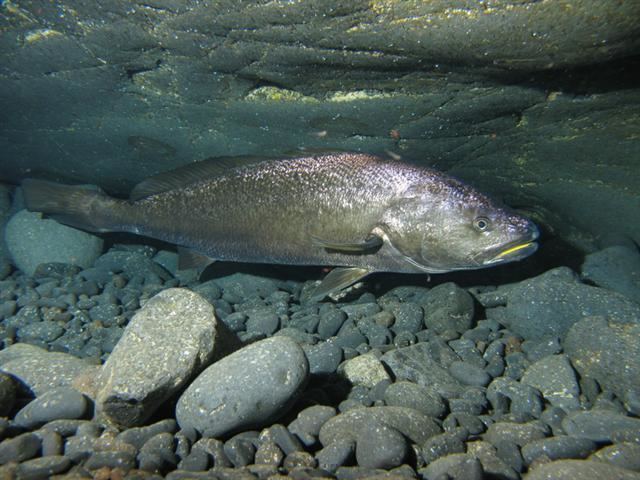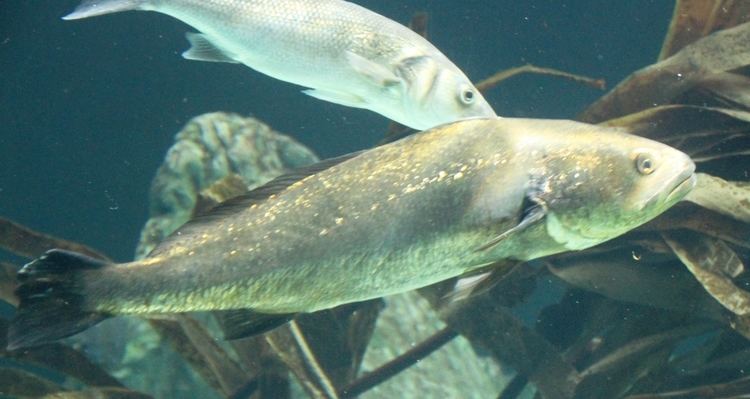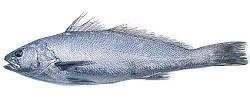Higher classification Argyrosomus | Order Perciformes Genus Argyrosomus Phylum Chordata Rank Species | |
 | ||
Similar Argyrosomus, Drums, Brown meagre, Umbrina cirrosa, Dicentrarchus | ||
Fishing in the atlantic ocean argyrosomus regius 1
Argyrosomus regius (also known as meagre, croaker, jewfish, shade-fish, corvina, salmon-bass or stone bass) is a fish of the family Sciaenidae. It has a similar form to a European seabass, with a pearly-silver coloration and a yellow-coloured mouth. Length can range from 40–50 cm to 2 m long, with weights up to 55 kg.
Contents
- Fishing in the atlantic ocean argyrosomus regius 1
- Fishing in the atlantic ocean argyrosomus regius 2
- Description
- Distribution
- Behaviour and life history
- Fisheries
- Aquaculture
- References

Fishing in the atlantic ocean argyrosomus regius 2
Description

Argyrosomus regius has a relatively large head with quite small eyes, the large mouth is at the terminal position and an elongated body. The lateral line is easily seen and extends all the way to the caudal fin. The rear dorsal fin is much longer than first one which has nine rays. The first ray of the anal fin is short and spiny while the second is very thin. The swim bladder contains several branched appendages which are vibrated to make a grunting sound which can be heard from up to 30m away and this grunting is produced by the males during the spawning season. Body colour pearly-silver, with bronze traits dorsally. The fin bases are reddish brown and mouth cavity yellow-gold or salmon pink. The scales are large and every fourth scale is set at a different angle from the rest. It can grow to 2m in length and 50 kg in weight.
Distribution

Argyrosomus regius is found in the eastern Atlantic from Norway to West Africa, including the Mediterranean Sea and the Black Sea. It has colonised the Red Sea by migrating through the Suez Canal. In Europe it is rare off the British Isles (three records) and Scandinavia.
Behaviour and life history

Argyrosomus regius is a demersal, oceanodromous fish which is found in inshore waters and on the continental shelf, it can occur close to the bottom as well as in surface and mid-waters. The adults prey on grey mullet and clupeids such as sardines which are actively pursued in open water. The adults gather in inshore waters to spawn during spring and summer. The juveniles and subadults prefer estuaries and coastal lagoons, and the health of recruitment into the adult population is possibly determined by the availability of these habitats. These fish are migratory, at all ages, migrating along shore or between offshore and inshore waters in response to temperature changes. A. regius feeds on fishes and swimming crustaceans and mostly occurs over sand, close to rocks, at 1–200 m max, but commonly found at 15–100 m. The three main spawning sites in the North Atlantic and Mediterranean Sea are the Nile delta, Lévrier Bay, and the Gironde estuary and with large numbers of adults congregate at these sites between May and July. Large schools of A. regius occur around wrecked ships that were deliberately sunk to create new habitat for a number of commercially caught species of fish. Most of their growth happens during the summer months and feeding activity is significantly reduced when the water temperature drops below 13-15 °C.

The newly hatched juveniles leave the estuaries where they spend the first few months at the end of summer and move into coastal waters with depths between 20 and 40 m where they spend the winter months. In the following Spring they return to their estuarine feeding areas from the middle of May. Water temperature is the most important factor that determines the trophic migration and reproduction of meagre. An adult female A. regius measuring 1.2m in length produces about 800,000 eggs and spawning occurs when the water temperature is 17-22 °C. The juveniles eat small demersal fish and crustaceans switching to pelagic fish and cephalopods once they grow to 30–40 cm in length.
Fisheries
Argyrosomus regius is fished for commercially using trawls, long lines, and hand lines. It is also a sport fishing quarry species. Specimens of 1.8 m in length and over 50 kg in weight which were landed in Portugal in 2002 fetched over €200. The main meagre fisheries are currently in Mauritania, Morocco, and Egypt and these account for over 80% of the annual world catch of around 10,000 tonnes. The European fisheries are comparatively small and are on the Atlantic coasts of Spain, Portugal and France with annual catches of 800 t in France, 400 t in Portugal and 150 t in Spain.
Aquaculture
The farming of Argyrosomus regius is still rather experimental and involves intensive production, in land-based tanks and sea cages. There are few facilities established mainly in southern France where they are in the Camargue, Cannes, and Corsica, and at La Spezia and Ortobello in Italy.
